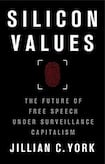
Perhaps no single phrase is as central to how we see the internet – for better or for worse – than “free speech”. Ever since the net left the confines of being primarily a government, research and large corporate communication tool and became a critical part of everyday life, freedom of speech has been a clarion call as well as a deeply contested term in debates over what could or should be posted, read, listened to and viewed online.
This is especially so at this particular Trump-contextualised moment, when this notion so central to democratic norms worldwide is in collision with “cancel culture” and deplatforming on social media. What does freedom of speech mean when the president of the country with this revered right embedded as a core constitutional value can be removed from global platforms at the behest of the private corporations that run them?
Or, more pointedly: Who decides, or should decide, those limits in the 21st century, where privately owned social platforms are a publishing format mightier than the combined reach of every media outlet on Earth?
We now have amplification networks beyond the imagining of the 18th-century men who made freedom of speech a First Amendment right in the US constitution, or the people who, almost two centuries later, considered freedom of expression an important European value to be fixed in the EU Charter of Fundamental Rights, or the US lawmakers who stuck the controversial section 230 into the 1996 Communications Decency Act, relieving internet platforms of legal liability for content posted by others.
In Silicon Values: The Future of Free Speech Under Surveillance Capitalism, Jillian York tackles these vexing and perplexing issues from the perspective of someone very much of the internet generation, as well as a well-known digital rights activist, writer and speaker. Her deep, direct experience working with global human rights activists who have experienced the net as both critical organising tool for democracy and freedom, and a vile, risky and threat-filled environment, gives her unique insights into what’s at stake when profit-focused private companies make speech and censorship decisions that at times can be, quite literally, a matter of life and death.
Hands-on expertise
That personal, hands-on expertise makes for some gripping tales, penetrating insight and persuasive advocacy, as anyone who has heard York speak over the years will know. She is now the Berlin-based director for international freedom of expression at US digital rights organisation the Electronic Frontier Foundation. Her personal conversations and interactions with activists – and, interestingly, some of the well-intentioned people working early on for the social networks – provide the kind of authentic, grounded foundation for her broader arguments that is inevitably absent from much academic work.
For example, York opens up to us the frontline experience of activists during events such as the much-heralded but later disappointing Arab Spring, giving a wide range of evidence on how platforms consistently (with rare exceptions) ignored pleas from activists and digital allies such as York to intervene to protect threatened activists. Too often, platforms are more responsive to repressive government demands to remove activist accounts on false pretences, or they simply don’t respond at all, or with minimal gestures, to reports of disinformation, bullying and threats.

Platforms – all huge US multinationals – also tend to see censorship, free speech and hate speech within a relatively narrow American framework. “But when nearly everyone has equal access to the same platforms, the simple fact that not everyone thinks alike – and certainly not everyone shares the same values as the Unites States – becomes strikingly clear,” she writes.
So, female nipples are censored on Facebook, nudity is banned on Instagram and Twitter, and sex workers are unable to network and share information that would keep them safer, as she outlines in chapters on “21st-century Victorians” and “The war on sex”. Meanwhile, platform efforts against incitement to violence and online hatred have focused inordinately on international terrorism, especially Islamic extremism, while doing little against, say, anti-Muslim rhetoric or white supremacists or US domestic terrorism. This even when anti-Muslim sentiment came from a US presidential candidate who continued such platform tirades in office, largely permitted until the start of this year because of a reluctance to remove speech by politicians.
According to York, it was a Dublin Facebook content moderation team that in 2015 unsuccessfully tried to explain internally “the global impact of allowing exceptions for the sake of US politics while systematically censoring political content from elsewhere”.
Unfortunately, the book was at the publishers by the time the platforms banned Trump. This development would certainly add yet another layer of complexity for York to explore in a volume premised on alarm at the degree to which platforms effectively are, despite Mark Zuckerberg’s rejection of the term, de facto “arbiters of truth” within the slippery constructs of free speech and hate speech.
Hate speech
Ultimately, this is the central conundrum York ponders at the end: how to address the impossibly convoluted problem of hate speech. As she confesses (and as I have heard her argue in the past at conferences), she used to believe free speech, no matter how offensive or hateful, should be allowed, that hate speech could best be countered by being scrutinised out in the open.
“Were it not for the platforms, I would still hold these views,” she states, adding that the problem is now not so much freedom of speech as “freedom of reach”. She closes the book with suggestions on how to move forwards and tackle these problems more effectively.
The lack of her detailed disclosure on this important shift in her perspective until the book’s close is regrettable. In individual chapters before then, at times York seems to reject limitations on speech, and yet also gives many examples of what she clearly sees as censorship and hate speech, risking the appearance of undercutting her own arguments. This is occasionally confusing.
Also – inexplicably – the book’s title seems an odd choice, as there’s never actually any significant exploration of how surveillance capitalism intersects with these free speech issues.
Consequently, I was expecting a different book. But the volume we are given – an important study of free speech under these pervasive social media platforms – is full of energy and needed insight at a moment when, post-Trump and mid-Covid, we need greater understanding of this weighty subject.










